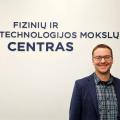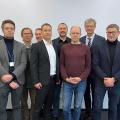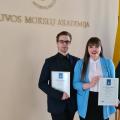Paieška
2024. 09. 05
-
"Point Defects in Semiconductors for Quantum Technologies". Lecture by Prof. Chris G. Van de Walle
-9b13a56e64af47906e212a592f71cc00.jpg)
Visualisation of Prof. Chris G. Van de Walle and his research team. Photo by University of California, Santa Barbara
On 13 September, Professor Chris Van de Walle, one of the world's leading researchers in theoretical materials science, from the University of California, Santa Barbara, will give a lecture at the FTMC. His topic is "Point Defects in Semiconductors for Quantum Technologies".
Don't miss the opportunity to meet this extraordinary guest and his world-renowned research!
Venue: FTMC conference room A101
Date ant time: 13 September, 11:00
About the topic:
"Quantum technologies have become a top research priority. However, the underlying hardware still requires major development. Point defects in semiconductors and insulators play a key role. On the one hand, they can be detrimental since they cause decoherence. On the other hand, they can act as functional centers, providing a platform that combines the environmental isolation necessary to maintain the coherence of quantum states with the ability to perform electrical and optical manipulation.
I will discuss first-principles analyses of a prototype quantum defect, the nitrogen-vacancy (NV) center in diamond, that elucidate its properties and form a foundation for predicting which centers in other materials might exhibit similarly favorable properties. Building on the general methodology for performing point-defect calculations, we have developed the capability to predict transition energies, lineshapes, and radiative and nonradiative rates. These developments enable us to analyze, identify, and predict quantum point defects, as will be illustrated with examples for a number of materials."
Bio:
Chris Van de Walle is a Distinguished Professor of Materials at the University of California, Santa Barbara and holds the Herbert Kroemer Endowed Chair in Materials Science. Prior to joining UCSB in 2004, he was a Principal Scientist at the Xerox Palo Alto Research Center (PARC). He received his Ph.D. in Electrical Engineering from Stanford University in 1986, and was a postdoctoral scientist at IBM Yorktown Heights (1986-1988) and a Senior Member of Research Staff at Philips Laboratories in Briarcliff Manor (1988-1991).
Van de Walle develops and employs first-principles computational techniques to model the structure and behavior of materials. He has published over 450 research papers and holds 24 patents. Van de Walle is a Member of the National Academy of Engineering, a Fellow of the APS, AVS, AAAS, MRS, and IEEE, as well as the recipient of the David Adler Award from the APS, the Medard W. Welch Award from the AVS, the TMS John Bardeen Award, and the MRS Materials Theory Award.
FTMC, Vilnius University and Lithuanian Quantum Technologies Association "Quantum Lithuania" information
Susiję:
 (3) (1)-006cd3bbb266f56c7be8ac63e32dc55e.png)
2024. 08. 27
-
Baltic Sandbox Ventures is looking for startups in the fields of quantum technologies, space and laser science!
The program offers mentorship, workshops, possibility to receive a grant, and networking with a global community of innovators.

2023. 12. 20
-
T. Paulauskas, the head of the Lithuanian Quantum Technologies Association: we want to create devices that help each one of us
What are the main goals of the Association? And what kind of technological breakthrough can we expect from Lithuanians?

2023. 11. 24
-
The Lithuanian Quantum Technologies Association is established
Dr. Tadas Paulauskas, a physicist at FTMC, became the head of the Association.
